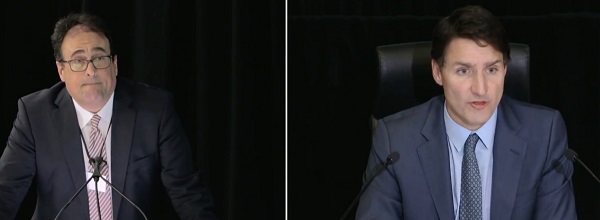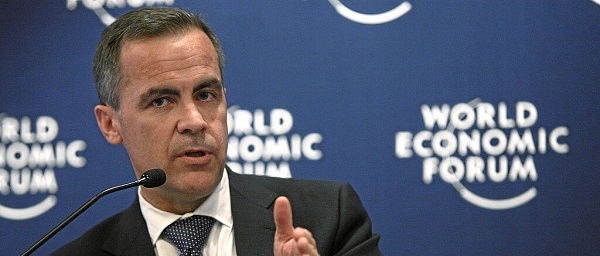National
Trudeau clinging like a ‘low-key autocrat’: Jeremy Nuttall

By Jeremy Nuttall
Is Canada looking like a developing nation with a corruption problem and a soft authoritarian regime?
This isn’t normal. Not even close. Even the most eccentric of Prime Ministers in any other commonwealth country would likely be licking their wounds in Ibiza by now, watching the chaos unfold from a safe distance.
Not this Prime Minister. True to form as the head of a micromanaging Prime Minister’s Office, he couldn’t bring himself to step aside. In fact, he still hasn’t.
Trudeau’s stubbornness edges dangerously close to the behavior of a low-key autocrat. He was nowhere to be seen for days as he shrugged off demands to “get lost in the snow.”
Imagine a country with a leader so deeply unpopular within his own party that members, mostly speaking anonymously out of fear, pressured him for months to step down—only for him to deflect with vague promises of “reflection” whenever the pressure mounted.
Imagine that happening against the background of the leader refusing to release documents as ordered by Parliament, at the same time the political landscape is embroiled in a foreign interference scandal. Meanwhile, food bank usage has surged, and concerns over soaring housing costs continue to grow.
Then, after a top minister leaves and drives a stake through his government, that leader circles his most loyal comrades in a bid to fend off the resignation even more before finally admitting defeat.
But even then, after the admission, said leader is still in charge and only promising to resign fully once his successor is chosen, then stopping the work of government at one of the most crucial times in recent history to give himself and his party time to get their affairs in order.
If you had that explained to you without knowing it was Canada, would you think it was a western parliamentary democracy being described, or a developing nation with a corruption problem and a soft authoritarian regime?
Democracies aren’t meant to prioritize the personal interests of government members over the country’s welfare. Yet that’s exactly what Trudeau did by requesting the prorogation of Parliament, giving his Liberals time to strategize for their own political survival.
Meanwhile, for the first few months of a new U.S. administration threatening major tariffs, Canada will be limited in its ability to address whatever happens in the House. With so much at stake, this move seems almost vindictive to a Canadian public who are now rejecting Liberal leadership.
Governor General Mary Simon’s decision to allow this—and the time she took to consider it—deserves scrutiny. The public is owed an explanation.
The Liberal Party’s troubles are not the Canadian public’s troubles, but in proroguing Parliament to deal with them, the Liberals have made them such.
Trudeau’s plan for the country is incoherent, his ministers suddenly have a lot of family obligations, and even columnists who curiously supported him for years too long are now calling for his exit.
Additionally, with him waiting until the Liberals are at their most unpopular ever, the Conservatives—set to win in a landslide no matter what—can control the narrative of the election and claim to have won on any mandate they see fit. The public could be left out of the conversation.
When tallied up, it’s all so awful.
In reality, however abnormal this is, it’s the natural course of where Canadians have allowed their country to end up.
Years of not really getting that upset about anything or realizing that the government and what it does matters are starting to show the real harms a country can be haunted by when it shrugs off the chipping away of its democratic norms by shallow and venal political operatives.
As pressure mounted on Trudeau to resign, his own MPs sheepishly asked for him to step down, an illustration that the PMO holds far too much power over caucus. One was left wondering if a breaking point would happen and MPs would make a grand gesture on behalf of Canadians.
Such a climax never arrived. My incredibly small kingdom for a handful of Liberal MPs with cojones.
The really sad part is, so far, it seems Liberal MPs missed a chance to turn the tide and more forcefully oust Trudeau from the leadership role by any means necessary, even if it meant voting against their own party.
They could have sent a message that democracy is a cumulative effort, not the whims of one person, then followed it up with reasonable changes to party policy to allow for the removal of a leader should such circumstances occur again.
What this has done is set a new low bar. The next power-crazed PMO will have this one as a blueprint to disregard the public and its welfare before pushing the limit even further.
The only bar lower at this point would be if Trudeau goes back on his promise to resign. Yes, it’s a long shot, but considering this guy’s track record of keeping promises—right up there with an absentee father in a daytime drama—I’ll really believe he’s gone when he’s gone.
This is a moment Canadians really need to examine and question if the way their government has been operating is working for them. If it isn’t, a movement for change must spring up.
Dignity, tradition, integrity, the common good—all of these principles risk becoming meaningless unless Canadians begin to take them seriously.
The Bureau is a reader-supported publication. To receive new posts and support my work, consider becoming a free or paid subscriber.
Agriculture
Canada’s supply management system is failing consumers

This article supplied by Troy Media.
The supply management system is cracking. With imports climbing, strict quotas in place and Bill C202 on the table, we’re struggling to feed ourselves
Canada’s supply management system, once seen as a pillar of food security and agricultural self-sufficiency, is failing at its most basic function:
ensuring a reliable domestic supply.
According to the Canadian Association of Regulated Importers, Canada imported more than 66.9 million kilograms of chicken as of June 14, a 54.6 per cent increase from the same period last year. That’s enough to feed 3.4 million Canadians for a full year based on average poultry consumption—roughly 446 million meals. Under a tightly managed quota system, those meals were supposed to be produced domestically. Instead imports now account for more than 12 per cent of this year’s domestic chicken production, revealing a growing dependence on foreign supply.
Supply management is Canada’s system for regulating dairy, poultry and egg production. It uses quotas and fixed prices to match domestic supply with demand while limiting imports, intended to protect farmers from global price swings and ensure stable supply.
To be fair, the avian influenza outbreak has disrupted poultry production and partially explains the shortfall. But even with that disruption, the numbers are staggering. Imports under trade quotas set by the World Trade Organization, the Canada-United States Mexico Agreement and the Comprehensive and Progressive Agreement for Trans-Pacific Partnership are running at or near their allowable monthly share—known as pro-rata
levels—signalling not just opportunity, but urgency. Supplementary import permits, meant to be used only in emergencies, have already surpassed 48 million kilograms, exceeding total annual import volumes in some previous years. This isn’t a seasonal hiccup. It’s a systemic failure.
The system, designed to buffer domestic markets from global volatility, is cracking under internal strain. When emergency imports become routine, we have to ask: what exactly is being managed?
Canada’s most recent regulated chicken production cycle, which ended May 31, saw one of the worst shortfalls in over 50 years. Strict quota limits stopped farmers from producing more to meet demand, leaving consumers with higher grocery bills and more imported food, shaking public confidence in the system.
Some defenders insist this is an isolated event. It’s not. For the second straight week, Canada has hit pro-rata import levels across all chicken categories. Bone-in and processed poultry, once minor players in emergency import programs, are now essential just to keep shelves stocked.
And the dysfunction doesn’t stop at chicken. Egg imports under the shortage allocation program have already topped 14 million dozen, a 104 per cent jump from last year. Not long ago, Canadians were mocking high U.S. egg prices. Now theirs have fallen. Ours haven’t.
All this in a country with $30 billion in quota value, supposedly designed to protect domestic production and reduce reliance on imports. Instead, we’re importing more and paying more.
Rather than addressing these failures, Ottawa is looking to entrench them. Bill C202, now before the Senate, seeks to shield supply management from future trade talks, making reform even harder. So we must ask: is this really what we’re protecting?
Meanwhile, our trading partners are taking full advantage. Chile, for instance, has increased chicken exports to Canada by more than 63 per cent, now accounting for nearly 96 per cent of CPTPP-origin imports. While Canada doubles down on protectionism, others are gaining long-term footholds in our market.
It’s time to face the facts. Supply management no longer guarantees supply. When a system meant to ensure resilience becomes a source of fragility, it’s no longer an asset—it’s an economic liability.
Dr. Sylvain Charlebois is a Canadian professor and researcher in food distribution and policy. He is senior director of the Agri-Food Analytics Lab at Dalhousie University and co-host of The Food Professor Podcast. He is frequently cited in the media for his insights on food prices, agricultural trends, and the global food supply chain.
Troy Media empowers Canadian community news outlets by providing independent, insightful analysis and commentary. Our mission is to support local media in helping Canadians stay informed and engaged by delivering reliable content that strengthens community connections and deepens understanding across the country.
Business
Prairie provinces and Newfoundland and Labrador see largest increases in size of government

From the Fraser Institute
By Jake Fuss and Grady Munro
A recent study found that Canada has experienced one of the largest increases in the size of government of any advanced country over the last decade. But within Canada, which provinces have led the way?
The size of government refers to the extent to which resources within the economy are controlled and directed by the government, and has important implications for economic growth, living standards, and economic freedom—the degree to which people are allowed to make their own economic choices.
Too much of anything can be harmful, and this is certainly true regarding the size of government. When government grows too large it begins to take on roles and resources that are better left to the private sector. For example, rather than focusing on core functions like maintaining the rule of law or national defence, a government that has grown too large might begin subsidizing certain businesses and industries over others (i.e. corporate welfare) in order to pick winners and losers in the market. As a result, economic growth slows and living standards are lower than they otherwise would be.
One way to measure the size of government is by calculating total general government spending as a share of the economy (GDP). General government spending refers to spending by governments at all levels (federal, provincial, and municipal), and by measuring this as a share of gross domestic product (GDP) we can compare across jurisdictions of different sizes.
A recent study compared the size of government in Canada as a whole with that of 39 other advanced economies worldwide, and found that Canada experienced the second-largest increase in the size of government (as a share of the economy) from 2014 to 2024. In other words, since 2014, governments in Canada have expanded their role within the economy faster than governments in virtually every other advanced country worldwide—including all other countries within the Group of Seven (France, Germany, Italy, Japan, the United Kingdom, and the United States). Moreover, the study showed that Canada as a whole has exceeded the optimal size of government (estimated to fall between 24 and 32 per cent of GDP) at which a country can maximize their economic growth. Beyond that point, growth slows and is lower than it otherwise would be.
However, Canada is a decentralized country and provinces vary as to the extent to which governments direct overall economic activity. Using data from Statistics Canada, the following charts illustrate which provinces in Canada have the largest size of government and which have seen the largest increases since 2014.

The chart above shows total general government spending as a share of GDP for all ten provinces in 2023 (the latest year of available provincial data). The size of government in the provinces varies considerably, ranging from a high of 61.4 per cent in Nova Scotia to a low of 30.0 per cent in Alberta. There are geographical differences, as three Atlantic provinces (Nova Scotia, Prince Edward Island, and New Brunswick) have the largest governments while the three western-most provinces (Alberta, Saskatchewan, and British Columbia) have the smallest governments. However, as of 2023, all provinces except Alberta exceeded the optimal size of government—which again, is between 24 and 32 per cent of the economy.

To show which provinces have experienced the greatest increase in the size of government in recent years, the second chart shows the percentage point increase in total general government spending as a share of GDP from 2014 to 2023. It should be noted that this is measuring the expansion of the federal government’s role in the economy—which has been substantial nationwide—as well as growth in the respective provincial and municipal governments.
The increases in the size of government since 2014 are largest in four provinces: Newfoundland and Labrador (10.82 percentage points), Alberta (7.94 percentage points), Saskatchewan (7.31 percentage points), and Manitoba (7.17 percentage points). These are all dramatic increases—for perspective, in the study referenced above, Estonia’s 6.66 percentage point increase in its size of government was the largest out of 40 advanced countries.
The remaining six provinces experienced far lower increases in the size of government, ranging from a 2.74 percentage point increase in B.C. to a 0.44 percentage point increase in Quebec. However, since 2014, every province in Canada has seen government expand its role within the economy.
Over the last decade, Canada has experienced a substantial increase in the size of total government. Within the country, Newfoundland and Labrador and the three Prairie provinces have led the way in growing their respective governments.
-

 Crime1 day ago
Crime1 day agoBryan Kohberger avoids death penalty in brutal killing of four Idaho students
-

 International2 days ago
International2 days agoCBS settles with Trump over doctored 60 Minutes Harris interview
-

 Business1 day ago
Business1 day agoWhy it’s time to repeal the oil tanker ban on B.C.’s north coast
-

 Energy1 day ago
Energy1 day agoIf Canada Wants to be the World’s Energy Partner, We Need to Act Like It
-

 Alberta1 day ago
Alberta1 day agoPierre Poilievre – Per Capita, Hardisty, Alberta Is the Most Important Little Town In Canada
-

 MxM News1 day ago
MxM News1 day agoUPenn strips Lia Thomas of women’s swimming titles after Title IX investigation
-

 Business1 day ago
Business1 day agoLatest shakedown attempt by Canada Post underscores need for privatization
-

 Alberta1 day ago
Alberta1 day agoAlberta Provincial Police – New chief of Independent Agency Police Service








